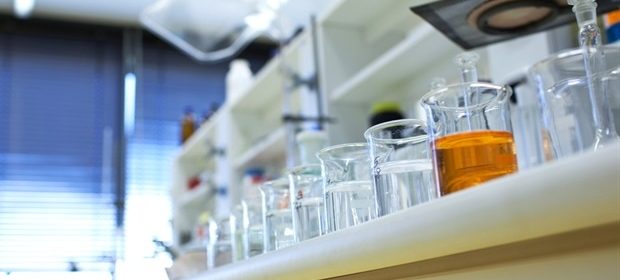Researchers disclose how a nanomachine takes care of cleaning up inside the cell

To prevent our body's cells from overflowing with garbage and to keep them healthy, the waste inside them is constantly being disposed of.
This cleaning process is called autophagy. Scientists have now, for the first time, rebuilt the complex nanomachine in the laboratory that starts this process – and it works quite differently from other cellular machines. The researchers' new insights could help open up new approaches for the treatment of cancer, immune disorders, and neurodegenerative diseases in the future, and possibly even delay aging.
Have you ever put off cleaning the house or decluttering the overflowing basement? Living cells cannot afford this procrastination when it comes to clearing the decks. Tiny garbage chutes are constantly active there to capture worn-out proteins, faulty cell components, or defective organelles. These garbage chutes, called autophagosomes, pick out the discarded components before they accumulate in the cell and cause damage.
The cellular waste is then passed on to the cell's own recycling machinery, the lysosome, where it is digested and recycled. Thus, building blocks for new cellular components are quickly available again. The autophagy process, literally self-eating, thus also helps cells to survive stress or periods of starvation.
Autophagy also serves another important purpose. It renders harmless viruses and bacteria that successfully bypass the immune system's defenses and reach the cell plasma. The consequences are correspondingly fatal if the autophagy process is faulty, too slow, or too fast. Neurodegenerative diseases and cancer can develop or disorders of the immune system may occur. Aging processes also appear to accelerate.
Autophagy is a highly complex process involving many different proteins and protein complexes. We know many of them, but there are still fundamental gaps in our knowledge. How do the protein components work together? How is the process of autophagy started and stopped? When and where is the autophagosome assembled? That is what we want to find out."
Alex Faesen, Research Group Leader, Max Planck Institute for Multidisciplinary Sciences in Göttingen
Nanomachine at work
His team has now succeeded, for the first time, in producing all the proteins involved in the autophagy process in the laboratory and observing them directly as the autophagosomes assemble. This was a mammoth task for the entire research group, taking several years, for which they cooperated with the teams led by Björn Stork from the University of Düsseldorf and Michael Meinecke, previously at the University Medical Center Göttingen now at the Heidelberg University Biochemistry Center. "There were many challenges," recalls Faesen. In the first step, the scientists produced each individual protein component in the laboratory. The standard approach is to use bacteria that are genetically reprogrammed to produce the desired protein in large quantities. "But protein production with bacteria did not work for any of our proteins," the Göttingen biochemist says. Instead, the researchers switched to insect cells as molecular helpers – the breakthrough.
In the next step, the team brought the individual protein complexes together. "The complexes self-assembled into a protein supercomplex, the autophagy initiation complex. In fact, autophagy involves a sophisticated cellular nanomachine – and it works quite differently than previously thought," the group leader says.
To make autophagosomes, the autophagy initiation complex first creates a junction between a particular structure of the cell, the endoplasmic reticulum, and the autophagosome that forms. Under stress or in times of starvation, such as during endurance sports, this occurs within just a few minutes. "From this point on, there is no turning back:
The waste disposal is assembled and collects the cellular waste," explains Anh Nguyen, one of the two first authors of the study. Co-first author Fancesca Lugarini adds, "Via the contact site, fat-like molecules called lipids are transported to a precursor stage of autophagosomes, where they are incorporated." These grow and, in the process, enclose the cell material to be disposed of – the finished mini-organelle is formed. Within barely 20 minutes of its formation, the autophagosome is already delivering its waste to the lysosome by fusing with it.
Protein origami for "on" and "off"
But what starts the assembly of the autophagy machine, what starts it and what stops it? The researchers did not find a molecular "on" and "off" switch as in other molecular machines. Instead, the switch uses a highly unusual behavior of proteins: metamorphosis. " Certain molecules, called ATG13 and ATG101, have the ability to fold in different 3D structures, thereby changing its ability to bind to proteins in the machine. "This protein metamorphosis also gives the go-ahead for the assembly of the autophagy initiation complex at the right time and in the right place," says Faesen, describing the special features of the nanomachine. Without metamorphosis, the initiation machine does not assemble.
The scientists hope that the new findings will advance the development of future drugs that can be used to treat diseases that are based on a faulty autophagy process.
Max-Planck-Gesellschaft
Nguyen, A., et al. (2023) Metamorphic proteins at the basis of human autophagy initiation and lipid transfer. Molecular Cell. doi.org/10.1016/j.molcel.2023.04.026.
Posted in: Cell Biology
Tags: Aging, Autophagy, Bacteria, Biochemistry, Cancer, Cell, Drugs, Immune System, Laboratory, Lipids, Living Cells, Neurodegenerative Diseases, Organelle, Protein, Research, Stress
Source: Read Full Article